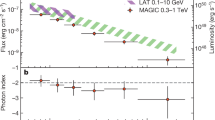Abstract
THE nature of the sources of cosmic γ-ray bursts is a long-standing problem in astrophysics. Lack of knowledge of their true spatial distribution and of their intrinsic brightness has hampered theoretical understanding of these enigmatic events. The Burst and Transient Source Experiment on the Compton Gamma-Ray Observatory has been detecting bursts at the rate of about one a day, and we report here an analysis of 153 events. The number versus intensity distribution does not follow the –3/2 power law expected for a spatially extended homogeneous distribution of sources, but at the same time the angular distribution is isotropic within statistical limits. Taken together, these results are inconsistent with the spatial distribution of any known population of galactic objects, but may be consistent with the bursts being at cosmological distances.
This is a preview of subscription content, access via your institution
Access options
Subscribe to this journal
Receive 51 print issues and online access
$199.00 per year
only $3.90 per issue
Buy this article
- Purchase on Springer Link
- Instant access to full article PDF
Prices may be subject to local taxes which are calculated during checkout
Similar content being viewed by others
References
Fishman, G. J. et al. in Proc. Gamma Ray Observatory Science Workshop (ed. Johnson, W. N.) 39–50 (NASA/GSFC, Greenbelt, 1989).
Golenetskii, S. Adv. Space Res. 8(2), 653–657 (1988).
Schmidt, M., Higdon, J. C. & Hueter, G. Astrophys, J. 329, L85–87 (1988).
Atteia, J.-L. et al. Nature 351, 296–298 (1991).
Ogasaka, Y., Murakami, T., Nishimura, J., Yoshida, A. & Fenimore, E. E. Astrophys. J. (in the press).
Mazets, E. et al. Astrophys. Space Sci. 80, 1–143 (1982).
Matz, S. et al. in Proc. Los Alamos Workshop on Gamma Ray Bursts (eds Ho, C. Epstein, R. & Fenimore, E. E.) (Cambridge University Press, in the press).
Chuang, K. W., White, R. S., Klebesadel, R. W. & Laros, J. G. Astrophys. J. (in the press).
Hartmann, D., & Epstein, R. I. Astrophys. J. 346, 960–966, (1989).
Brock, M. N. et al. in Proc. Gamma Ray Bursts 1991 (eds Fishman, G. J. & Paciesas, W. S.) (in the press).
Cline, T. L. et al. in Proc. Gamma Ray Bursts 1991 (eds Fishman, G. J. & Paciesas W. S.) (in the press).
Hurley, K. et al. in Proc. GRO Annapolis Workshop (in the press).
Schoenfelder, V. et al. IAU Circ. No. 5369 (1991).
Paczynski, B. Astrophys. J. 348, 485–494, (1990).
Brainerd, J. J. Nature (in the press).
Atteia, J.-L. & Hurley, K. Adv. Space Res. 6(4), 39–43, (1986).
Paczynski, B. Acta Astr. 41, 157–166 (1991).
Paczynski, B. Acta Astr. 41, (in the press).
Author information
Authors and Affiliations
Rights and permissions
About this article
Cite this article
Meegan, C., Fishman, G., Wilson, R. et al. Spatial distribution of γ-ray bursts observed by BATSE. Nature 355, 143–145 (1992). https://doi.org/10.1038/355143a0
Received:
Accepted:
Issue Date:
DOI: https://doi.org/10.1038/355143a0
This article is cited by
-
A novel trigger algorithm for wide-field-of-view imaging atmospheric Cherenkov technique experiments
Nuclear Science and Techniques (2022)
-
Self-organized criticality in multi-pulse gamma-ray bursts
Frontiers of Physics (2021)
-
Detection of GRBs at high altitudes with a prototype water Cherenkov detector using single-particle technology
Astrophysics and Space Science (2020)
-
Neutron star mergers and how to study them
Living Reviews in Relativity (2020)
-
On the limit between short and long GRBs
Astrophysics and Space Science (2015)
Comments
By submitting a comment you agree to abide by our Terms and Community Guidelines. If you find something abusive or that does not comply with our terms or guidelines please flag it as inappropriate.



